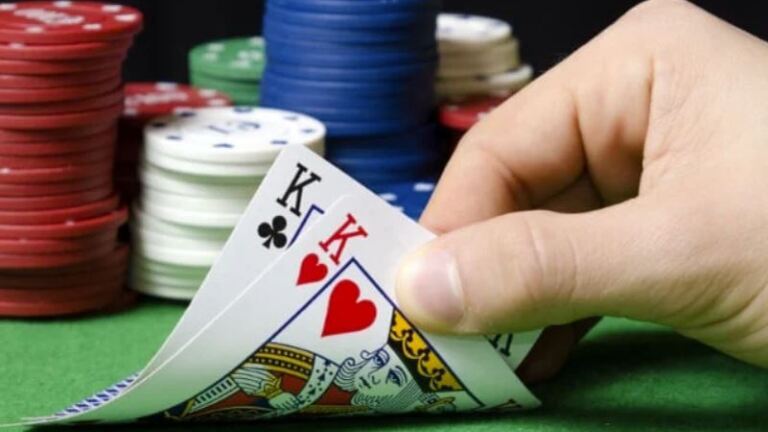
Basics
In order to understand the meaning of floating, we should look at its usage first. The word ’float’ means something like ’drift’, ’glide’, ’hover’ and ’hang’. In poker, it means that we have a not-so-very-secure hand on the flop and continue playing in order to take down the pot later.
Floating is a bit similar to bluffing, and is typically carried out on the flop or the turn. The main aim (of calling on the flop and raising on the turn) is to daunt our opponents into thinking we have a better hand and aim to take the pot without seeing the river. A very important part of floating is that we call the opponent’s bet on the flop and if they check on the turn, we take the pot with a firm raise. This can be carried out with any two cards, this is why sometimes floating is considered a sneaky bluff. We have to add here, that it is never a good idea to call pre-flop with any two just to be able to float. A float consists of two streets (flop and turn) and does never include the river.
Understanding the idea of floating
As mentioned above, a player who intends to be a master of floating should be very clear with pre-flop and post-flop gameplay and should know what a C-bet is. The player also has to be able to classify their opponents and know exactly when and how often the opponents use the C-bet option. This means you have to be able to correctly read your opponent.
If you think you are in this category, you must know that most of the TAG players will C-bet after a pre-flop raise, no matter what the flop brings and you will also notice when the flop is not suitable for your opponent. Let’s look at it from your point of view:
You are holding two high cards and raise from an early position. You receive one call. Unfortunately, the flop misses you, but its structure makes you think the C-bet is a good option. After some thinking, your opponent calls. The turn is no good.
What do you do in a situation like this?
Usually, you would check on the turn, because, considering your opponent’s call, they either have a better hand or some kind of draw. The size of the pot on the turn is usually so large that a TAG will not risk a raise with nothing, so the player that called on the flop will take the pot with one simple bet (it does not matter if he really had a strong hand or just floated).
Numbers and statistics – from the floater’s point of view
Let’s have a lok at the scenario mentioned above, us being the pre-flop callers in this example:
NL100 – 6-max
Postition: Cut-Off
Your Hand:
All players have $100
The TAG raises to $3.5 from UTG+1. You call from Cut-Off. If you have a look at the table below, you will see that your opponent raises from MP in 10% of all cases, which means that we can put him in the following zone:

The flop comes
It is also worth considering your odds against the above mentioned range, but this is not very important on the flop. The reason for this is that your opponent will check with many hands that are better than yours, and might even fold to your raise on the turn.

You decide to float with your two overcards (do not forget that you still have 6 outs). The turn is
This will turn out well in most cases, but, of course, if your opponent calls or re-raises on the turn, it is best to stop floating and give up the fight.
Float play and its positional requirements
If you want your float play to be truly successful, you should only use it in a one-on-one situation, in position.
Why is this important?
Let’s have a look at how the game mentioned above would have went down if you had been out of position. You would not have had the opportunity to win the game with a bluff on the turn, as you would not have had any information on your opponent’s hand at that point.
Of course, another type of floating is when you are out of position and raise on the river after the opponent checked on the turn, but the efficiency of this is smaller than that of a turn bet. This is because there will be much less money in the pot. This means, that the opponent will not have to fear facing a huge bet on the river.
Last, but not least: if you are out of position, you will give your opponent a free card, which is never a wise thing to do.
Second barrel, a.k.a what happens, if your opponent bets again on the turn?
Folding would be the best option in the majority of these cases. It is not worth fighting a losing battle. It is true, that some players holding nothing will bet on the turn no matter what, just because they know you have the option to float. At this point, it comes down to how well you know the player you are facing, and what they know about you. This includes all information indicated by previous hands. If you think you know your opponent well enough and see through his second barrel, you can try taking the pot with a re-raise on the turn. Be careful, though, as this is a very dangerous situation, the pot will increase dramatically and you will have to risk big amounts of money to carry out your bluff. This type of play is only recommended for the most experienced players.
When is it worth to consider floating?
As mentioned above, floating is mostly useful against tighter players, who can fold to a C-bet. Their range should be easy to tell.
Floating should not be used against players who will follow you to the river with very weak hands. To put it in other words, if your opponent is a calling station, you should wait until you receive a truly strong hand.
Another important issue with floating is that you have to be able to recognize the flops that are truly worth floating. A flop like
How often should you be floating?
It is quite easy to become an addict to floating, but is should be in your best interest to control yourself and decrease the number of situations in which you float, because your opponents could easily turn your own weapon against you by a simple check-raise. On the other hand, you can also raise against frequent floaters, but only if you have a good hand in your possession.
Conclusion
Floating can be a useful tool of a poker player, and can be an aid to collect BBs and improve long-term efficiency. To understand and use the rules mentioned above is very important at tables above NL100 and becomes a completely average part of gameplay later on.















0 comments